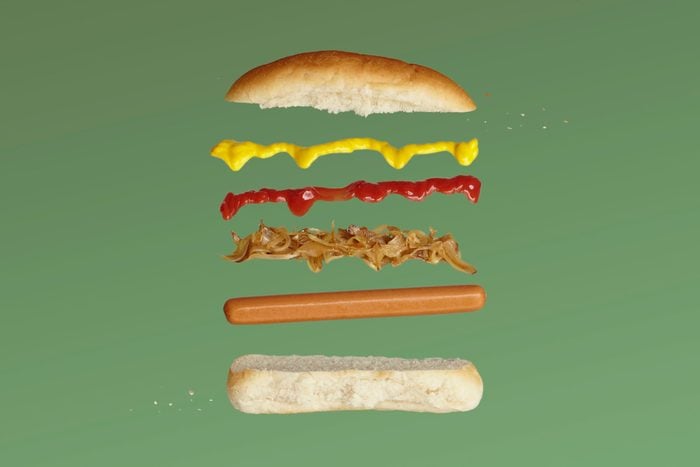Is a Hot Dog a Sandwich? What Experts Say
Updated: Sep. 08, 2023

Hot dog, wiener, frankfurter—call it what you want, but according to some culinary experts, you shouldn't call it a sandwich.
Does God exist? Are we alone in the universe? What came first: the chicken or the egg? All important questions and the kind of murky hypotheticals that inspire rigorous debate in the hallowed halls of universities, at dinner tables, on the Internet, and of course, a few drinks in at a party. And for the past decade, another contentious thought experiment has kept inquiring minds up at night, making memes, and arguing in the furthest reaches of Reddit: Is a hot dog a sandwich?
To be frank(furter), it’s just one of the many wiener-related queries that boggle the mind. Like why there are always eight hot dog buns in a pack when hot dogs are sold in packs of ten. Even more basic is “what are hot dogs made of?”
For the purpose of this article, we’ll skip other debates and food facts trivia to remain hyper-focused on whether the hot dog belongs in the same category as BLTs, clubs, pastrami sandwiches, and Reubens. We grilled experts from both sides of the grocery aisle to see if we could reach a consensus on the stadium staple’s status. But first: a bite—err, bit—of history.
On This Page
Who invented the hot dog?
Much like the “is a hot dog a sandwich?” question and the birthplaces of many favorite foods, this inquiry is hotly contested, according to the National Hot Dog and Sausage Council (NHDSC). The city of Frankfurt, Germany, usually takes credit for the invention of the frankfurter, and even celebrated the food’s 500th birthday in 1987.
The foodies of Vienna, Austria, assert they are the originators of the hot dog and use the fact that we call it a wiener as their proof. After all, the city is called Wien in the Austrian German language.
Others claim a popular sausage called a dachshund (“little dog”) was invented by butcher Johann Georghehner in the late 1600s in Coburg, Germany. But the hot dog as we know it likely evolved from common sausages brought to American shores by generations of immigrant butchers from a variety of European countries.
Why is it called a hot dog?
Also disputed is how the wiener came to be called a hot dog. The most likely scenario, according to the NHDSC, is that it started with ol’ Johann’s canine-inspired nickname for the long, skinny frankfurters. It traveled to America with Germans in the 1800s and then got anglicized over the years.
The word “hot dog” started appearing in college magazines in the 1890s. In 1894, there’s a record of “dog wagons” selling hot dogs to dorm dwellers. And there was a joke about what the meaty tubes were made of.
But there is another story about how the tern was coined—it’s more fun to tell though likely made up. In that recounting, vendors were selling hot dogs at the New York Polo Grounds in 1901 and saying things like, “Get your dachshund sausages while they’re red hot!” Supposedly, a popular New York Journal cartoonist, Tad Dorgan, witnessed the scene and drew a cartoon with barking sausages in rolls. He didn’t know how to spell “dachshund,” so he simply called it a hot dog.
A dent in the validity of that origin story: According to the NHDSC, historians have been unable to locate the cartoon.
What is a sandwich?
Two important definitions likely sparked the “is a hot dog a sandwich?” conversation. According to Merriam-Webster dictionary, the definition of “sandwich” is “two or more slices of bread or a split roll having a filling in between,” as well as “one slice of bread covered with food.” (That second bit helps make sense of open-faced sandwiches.)
The U.S. Department of Agriculture (USDA) describes a sandwich as “two slices of bread, or the top and bottom sections of a sliced bun, that enclose meat or poultry.” When food experts try to nail down whether or not hot dogs are a sandwich, they refer back to the USDA’s wording.
Why is a hot dog technically a sandwich?
According to the official definition, a hot dog is a sandwich. Using loose interpretations of the USDA’s definitions, Rich Hope, chief marketing officer at sandwich chain Jersey Mike’s, says, “There are many ways to do sandwiches, [so] sure, hot dogs can be sandwiches. [Just] not sub sandwiches.”
Because a hot dog is meat flanked by bread and smeared with condiments like ketchup and mustard, which sounds a lot like a sandwich, it’s easy to see why people in this camp have a leg to (hot dog) stand on. It’s also why over at Applegate—a company that offers lunch meat, American cheese singles for sandwiches, and some of the best hot dogs on the market—employees relish the opportunity to regularly debate whether a hot dog is a sandwich, according to senior brand manager Gina Gancheva.
“We have employees on both sides,” she says. “Based on the current definition set by the USDA, yes, a hot dog is technically a sandwich. However, the majority of us, including myself, believe in our hearts that a hot dog is not a sandwich.”
She notes that the USDA’s limited terminology is problematic and rules out large swaths of the sandwich family, including peanut butter and jelly. “If we went by the USDA, the beloved grilled cheese would not qualify,” she says. “And what about vegetarian or vegan sandwiches that are absent of meat or poultry?”
Why is a hot dog not really a sandwich?
While most experts were hesitant to put their foot down on one side of the debate, those in favor of letting the dogs out of the sandwich category were far more adamant.
“A hot dog is its own unique thing, a cylindrical-shaped protein that sits in a bun, and not a sandwich,” says Phil McCann, vice president of marketing at Nathan’s Famous, the Coney Island institution that hosts the annual Fourth of July Hot Dog Eating Contest. “A hot dog certainly is deserved of its own category, the same way a burger deserves its own. Sandwiches have their own category as well, and that category does not include hot dogs or burgers.”
Joey Chestnut, the 14-time winner of the aforementioned contest, took to Twitter in 2017 to affirm that he doesn’t endure these gross realities of competitive eating for just any ole ‘wich. “It’s #NationalHotDogDay. As president, I want it to be known the hot dog stands free and independent from the tyranny of the sandwich.”
Given that Americans spent more than $7.5 billion at U.S. markets on dogs and sausages in 2021, Eric Mittenthal, president of the NHDSC (aka hot dogs’ top dog), argues that franks have outgrown generic sandwich classification. “Perhaps at one time its importance could be limited by forcing it into a larger sandwich category, but that time has passed. Saying it’s just a sandwich is like calling the Dalai Lama just a guy.”
It’s a matter of bread
Mittenthal also argues that to qualify as a sandwich there must be a bread component. “It’s called a hot dog when it’s on a bun. It’s called a hot dog when it’s not,” he says. “The bun is irrelevant to the nature of the hot dog; therefore, it is not a sandwich.”
It’s a matter of history
McCann points out that it’s an issue of semantics. “The sandwich was supposedly invented in 1762 by John Montagu, the fourth Earl of Sandwich. He requested that sliced meat be placed between two slices of bread, which he could eat with his hands. That is not the definition of a hot dog,” McCann says. “What’s more, if the sandwich was invented in 1762, why wouldn’t they have called the hot dog a sandwich when it was invented 100 years later, if it was a sandwich?”
It’s a matter of language
Lest you think this is some sort of East Coast anti-sandwich alliance, we sought out Richard Pink, the co-owner of Pink’s Hot Dogs, to get his take. His frankfurter-focus restaurant has been a Los Angeles landmark since his parents started the joint in 1939. Incidentally, the city’s residents consume more hot dogs than any other in the United States—a whopping 30 million pounds a year! He agrees that it is a matter of accepted linguistics.
“In common parlance and practice, at least in America, if you asked people to tell you what a hot dog is, they would not describe a sandwich. And if you asked them to define a sandwich, no one would say, ‘a tubular piece of meat that fits into a bun,'” Pink says. “If someone came into Pink’s and said, ‘I want a sandwich,’ we’d politely say, ‘We don’t serve those. We have hot dogs and hamburgers.'”
The verdict
After talking to experts, we’re no closer to declaring this discourse solved. (We can, however, put to rest the question of whether a hot dog is a taco. The definitive answer is no; the Mexican dish requires filling to be surrounded by a tortilla.)
For every pro that voted no, another with hot dog skin in the game weighed in on the other side of the philosophical spectrum, just as Oscar Mayer did back in 2018. The company posted on social media that hot dogs are sandwiches, then it opened a hotline for naysayers to try to convince them otherwise.
Even regular Joes and Janes remain hotly divided. The NHDSC has done several surveys over the years, and usually, the results are roughly 60:40 in favor of hot dogs and hoagies not being related. Mittenthal notes that in the most recent poll, taken in 2021, just over half of all respondents said they don’t believe dogs belong in the sandwich category.
He’s dubious the nation even wants to stop parleying about whether a hot dog is a sandwich or not. “Hot dogs are a beloved American food and hearty debate is an American tradition,” he says. “It’s fun to talk about. The debate has raged for years and shows no signs of letting up.”
Our suggestion: Forget the definition and simply enjoy the dish. Squeeze on some ketchup or mustard, top with relish or go wild with chili, peppers and onions, bacon, or sauerkraut. And then place an order of french fries for one of the most American meals of all time.
Next, check out which place has the best hot dog in each state.
Sources:
- Rich Hope, chief marketing officer at sandwich chain Jersey Mike’s
- Gina Gancheva, senior brand manager at Applegate
- Phil McCann, vice president of marketing at Nathan’s Famous
- Eric Mittenthal, president of the National Hot Dog and Sausage Council
- Richard Pink, the co-owner of Pink’s Hot Dogs
- National Hot Dog and Sausage Council: “Hot Dog History”
- U.S. Department of Agriculture: “Food Standards and Labeling Policy Book”
- @JoeyJaws: “Joey Chestnut on Twitter”
- @OscarMayer: “Oscar Mayer on Twitter”
- National Hot Dog and Sausage Council: “Americans Resolve Fiercest Hot Dog Disputes”






